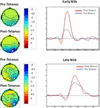In vivo evidence for neuroplasticity in older adults
- PMID: 25857946
- PMCID: PMC4666311
- DOI: 10.1016/j.brainresbull.2015.03.004
In vivo evidence for neuroplasticity in older adults
Abstract
Neuroplasticity can be conceptualized as an intrinsic property of the brain that enables modification of function and structure in response to environmental demands. Neuroplastic strengthening of synapses is believed to serve as a critical mechanism underlying learning, memory, and other cognitive functions. Ex vivo work investigating neuroplasticity has been done on hippocampal slices using high frequency stimulation. However, in vivo neuroplasticity in humans has been difficult to demonstrate. Recently, a long-term potentiation-like phenomenon, a form of neuroplastic change, was identified in young adults by differences in visual evoked potentials (VEPs) that were measured before and after tetanic visual stimulation (TVS). The current study investigated whether neuroplastic changes in the visual pathway can persist in older adults. Seventeen healthy subjects, 65 years and older, were recruited from the community. Subjects had a mean age of 77.4 years, mean education of 17 years, mean MMSE of 29.1, and demonstrated normal performance on neuropsychological tests. 1Hz checkerboard stimulation, presented randomly to the right or left visual hemi-field, was followed by 2min of 9Hz stimulation (TVS) to one hemi-field. After 2min of rest, 1Hz stimulation was repeated. Temporospatial principal component analysis was used to identify the N1b component of the VEPs, at lateral occipital locations, in response to 1Hz stimulation pre- and post-TVS. Results showed that the amplitude of factors representing the early and late N1b component was substantially larger after tetanic stimulation. These findings indicate that high frequency visual stimulation can enhance the N1b in cognitively high functioning old adults, suggesting that neuroplastic changes in visual pathways can continue into late life. Future studies are needed to determine the extent to which this marker of neuroplasticity is sustained over a longer period of time, and is influenced by age, cognitive status, and neurodegenerative disease.
Keywords: Neuroplasticity; Normal cognitive aging; Tetanic visual; Visual evoked potentials (VEPs).
Copyright © 2015 Elsevier Inc. All rights reserved.
Figures
References
-
- American Psychiatric Association. Diagnostic and Statistical Manual of Mental Disorders (4th ed.) Washington, DC: American Psychiatric Association; 1994.
-
- Bao JX, Kandel ER, Hawkins RD. Involvement of pre- and postsynaptic mechanisms in posttetanic potentiation at Aplysia synapses. Science. 1997;275(5302):969–973. - PubMed
-
- Bliss TV, Collingridge GL. A synaptic model of memory: long-term potentiation in the hippocampus. Nature. 1993;361(6407):31–39. - PubMed
Publication types
MeSH terms
Grants and funding
LinkOut - more resources
Full Text Sources
Other Literature Sources
Medical


